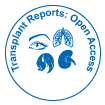Brief Notes on Liver Transplant Reports
Received Date: May 27, 2022 / Accepted Date: Jun 23, 2022 / Published Date: Jun 24, 2022
Abstract
Throughout recent years, liver transplantation has arisen, advanced and is presently the essential treatment for end-stage-liver infection. Since the joining of the Model for End-Stage Liver Disease (MELD) framework, there has been a viable decrease in the mortality of applicants on the liver holding up list. The absence of organs for gift is the main pressing concern for a liver transfer, and the quantity of organs is still lower than patients on the holding up list. Hence, logical proof that any given condition doesn't handicap a liver from being given is generally invited. Writing is basically nonexistent in records of a liver gift from patients who passed on from contact with venomous snakes and reptiles, despite the fact that there is proof of fruitful transplantation including expired kidney givers from snakebites. Albeit in Brazil alone there are around 100 passings each year because of this cause, Bothrops jararaca and Bothrops atrox represent 90% of snake poisonings. The death rate is 0.5% and is connected with how much toxin immunized, season of care (in a perfect world < 6 hours) and characteristic variables of the patient. This case report is about an uncommon event in which a liver is given for transplantation after the benefactor is pronounced with encephalic passing because of snakebite of the Bothrops jararaca species. Orthotopic Liver transplantation is the essential treatment for most end-stage-liver sicknesses. Casualties of snakebite are potential organ contributors since the toxin's capacity to instigate irreversible mind harm. Be that as it may, in the writing, reports of liver transfers acquired from casualties of these mishaps, their result and follow up are basically non-existent. Our motivation is to report an instance of a giver with cerebrum demise following complexities of a bothropic mishap, and the patient who gets the liver with cirrhosis because of Hepatitis B.
Citation: Petric M, Fiel I, Kawana M (2022) Brief Notes on Liver Transplant Reports. Transplant Rep 7: 142. Doi: 10.4172/troa.1000142
Copyright: © 2022 Petric M, et al. This is an open-access article distributed under the terms of the Creative Commons Attribution License, which permits unrestricted use, distribution, and reproduction in any medium, provided the original author and source are credited.
Share This Article
Recommended Journals
Open Access Journals
Article Tools
Article Usage
- Total views: 2095
- [From(publication date): 0-2022 - Apr 04, 2025]
- Breakdown by view type
- HTML page views: 1760
- PDF downloads: 335
